This New York strip roast is dry-brined, reverse-seared, and coated in an incredibly flavorful herb butter for the perfect large gathering entrée. Your friends and family will be blown away by how tender, juicy, and flavorful this roast turns out.
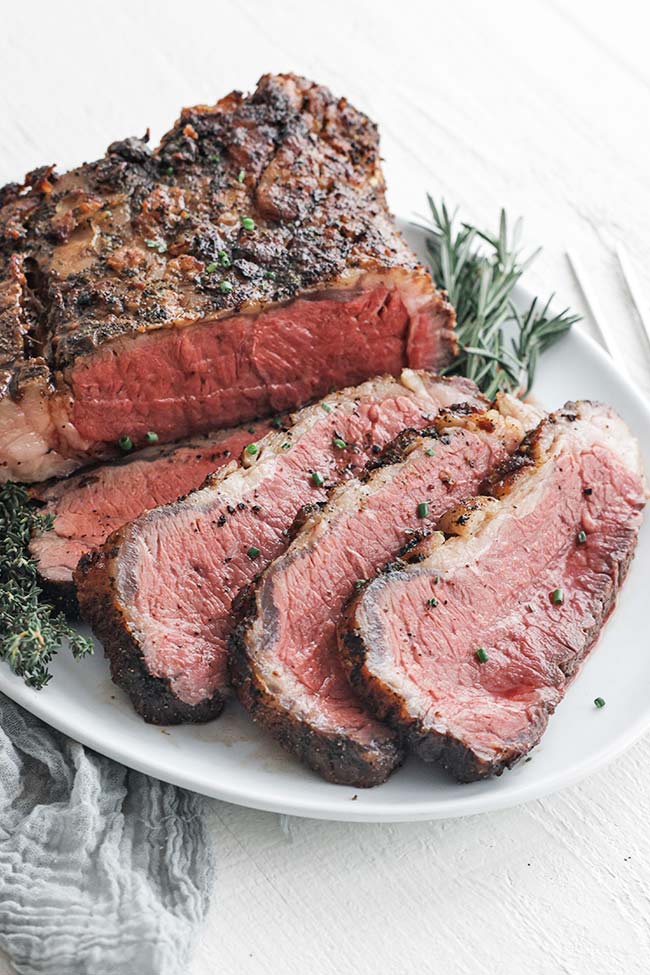
I love making large roasts, whether we’re entertaining guests or just cooking for the family. It’s one of those meals that tastes even better the next day, and we always enjoy having leftovers. If you’re the same way, you’ve got to try my smoked New York strip roast recipe, or for an easy, comforting option, my slow cooker pot roast is a hands-off meal.
New York Strip Roast
New York strip roast is a large cut of beef that comes from the top of the short loin behind the ribs in the center back of the cow. It’s not an overly used muscle, so it’s a tender cut with good intramuscular fat running through it and a fat cap on top.
When this large cut of meat is cut into individual portions, you get your New York strip steaks. When left whole, it’s an excellent piece of meat, perfect for roasting at high or low temperatures or reverse searing, which is exactly what I did.
My New York strip roast recipe is incredibly versatile and can be easily customized with herbs, butter, herb-infused oils, or your favorite seasoning blends. No matter how you flavor it, it always turns out tender, juicy, and packed with rich flavor!
Ingredients and Substitutions
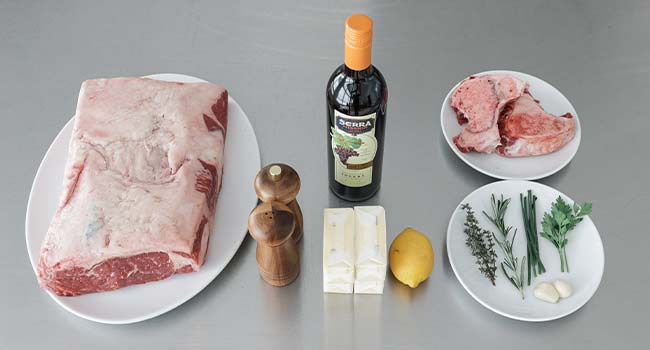
- Beef – Any strip sirloin will work for this recipe. I prefer a pasture-raised New York strip roast because of its fat cap and marbling. You can also look into different grades, such as choice, prime, or Wagyu. Expect to pay $14 to $25 per pound. You can also use a bone-in roast.
- Butter – I always prefer unsalted butter to control the sodium content instead of the butte company.
- Lemon – Some zest and freshly squeezed lemon juice add a hint of clean acid to the beef for a smooth finish.
- Herbs – This is subjective, but the herbs I love in the herb butter are fresh parsley, chives, thyme, and rosemary. You can substitute it with dry herbs using half the amount of fresh herbs.
- Garlic – A few finely grated garlic cloves add just enough garlic to the butter and roast.
- Marrow – This is optional, but I roasted beef shank bones and blended the marrow with the herb butter to give it a beefier, umami flavor.
- Wine – I added some dry sherry to the butter because it’s such a compliment to beef.
- Seasonings – Only coarse salt and ground black pepper were used in the seasoning for the roast. Figure 1 tablespoon of salt and 1 teaspoon of pepper per 4 pounds of meat for all large roasts.
How to Make a New York Strip Roast
Trim the Fat: I start by trimming excess fat from the roast, leaving just enough to keep it juicy and flavorful while it cooks.
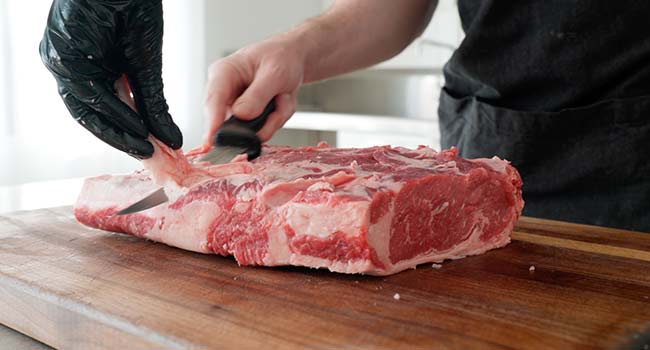
Score the Fat Cap: I carefully score the fat cap with a sharp knife, making shallow cuts across the surface.
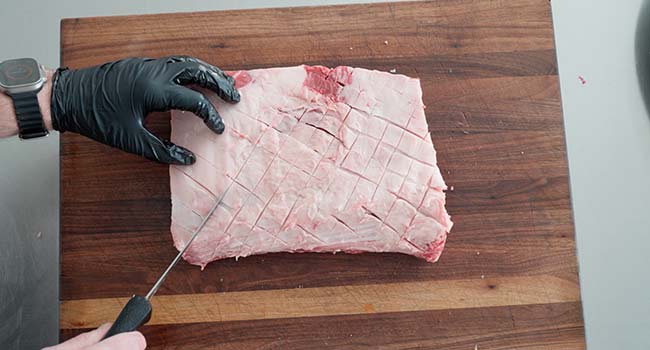
Truss the Roast: Next, I truss the beef roast using butcher’s twine.
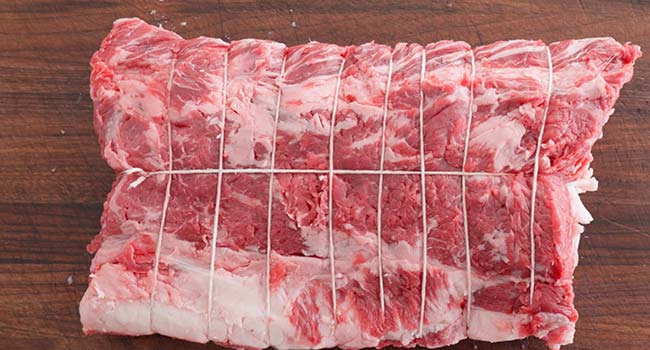
Season the Roast: I place the trussed roast on a rack over a sheet tray, then generously season all sides with salt and pepper.
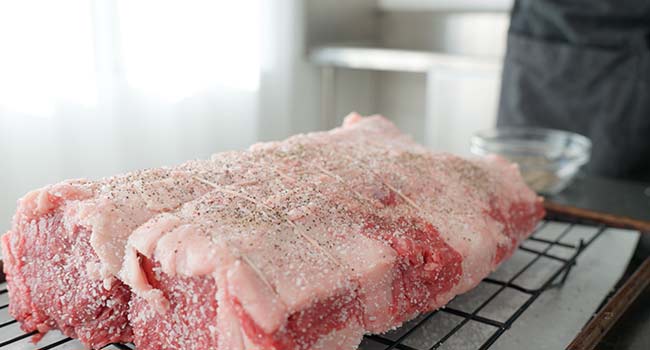
Dry Brine the Roast: I place the seasoned roast on the rack in the fridge, uncovered, and let it rest for 12 to 48 hours.
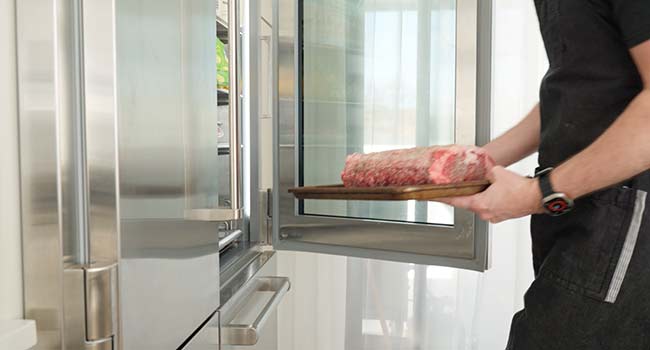
Bring to Room Temperature: I take the roast out of the fridge and let it sit at room temperature for 25-30 minutes.
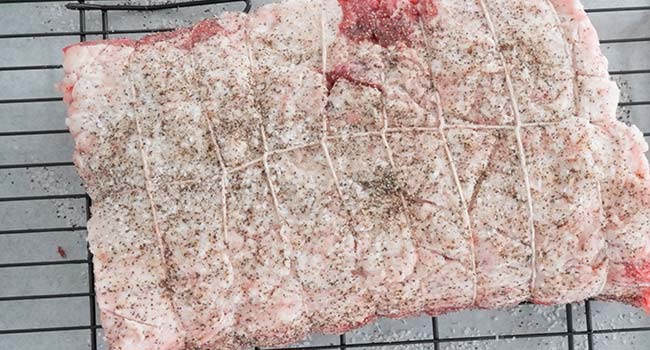
Whip the Butter: I add unsalted butter to my stand mixer fitted with the paddle attachment and whip it on high speed for 5 to 7 minutes.
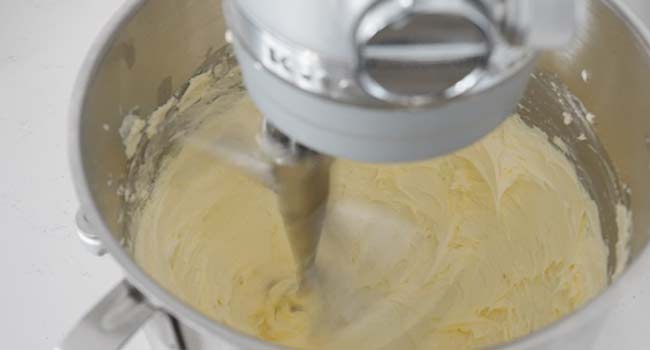
Flavor the Butter: I stop the mixer and add fresh herbs, lemon zest, lemon juice, salt, pepper, and sherry. Then, I mix on low speed until everything is evenly combined.
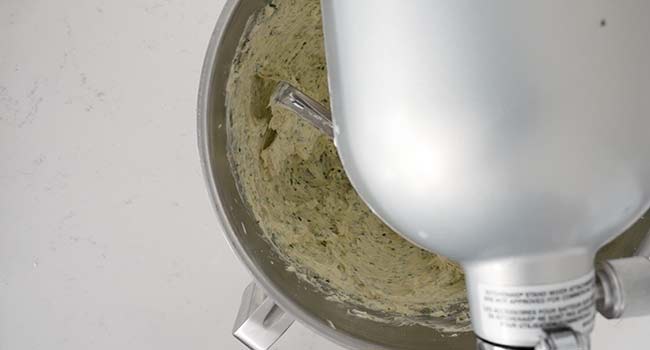
Coat with Herb Butter: I spread half of the herb butter evenly over the fat cap, ensuring it’s well-coated.
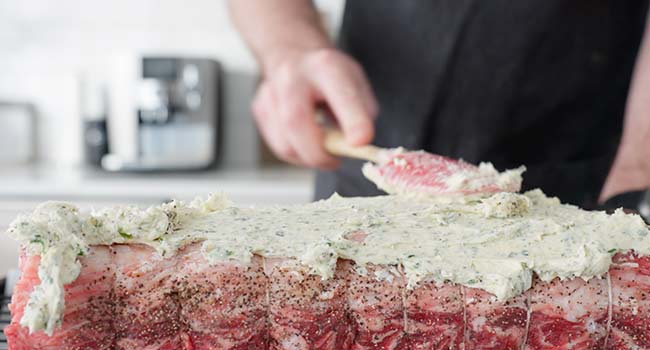
Slow Roast & Monitor: I Place a thermometer from the top into the center of the roast and reverse sear it on a middle rack in the oven at 225° until it reaches 108° to 110° internally.
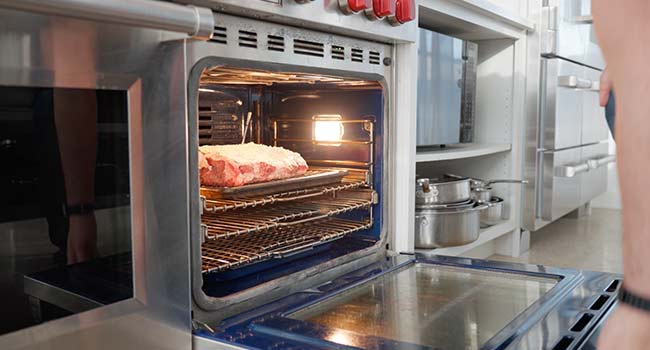
Let It Rest: I remove the roast, cover it with foil, and let it rest for 60 to 75 minutes.
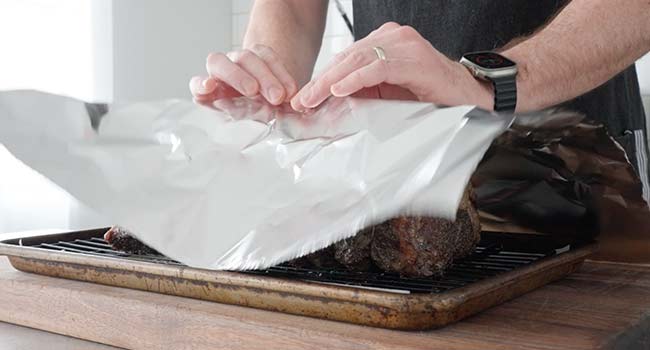
Preheat the Oven: While the roast rests, I increase the oven temperature to 500°F. If you have a convection oven, even better, it helps achieve an extra-crispy, golden-brown crust.
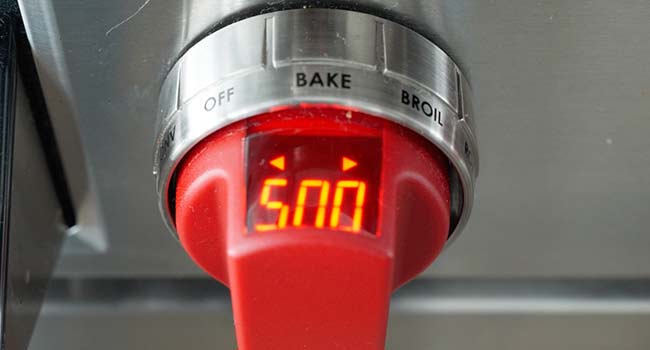
Roast the Beef Shank Bones: I coat the beef shank bones with oil, salt, and pepper, then place them on a parchment-lined sheet tray. I roast them on the middle rack of a 500°F oven for 20 to 25 minutes
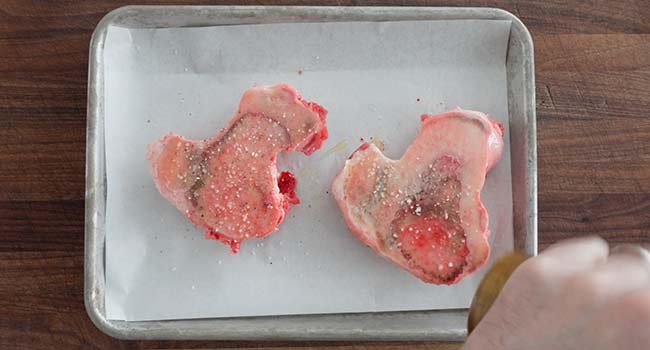
Make the Bone Marrow Butter: I let the bones cool before adding the marrow to a food processor with the remaining herb butter. Pulse it until it is finely minced and combined with the butter.
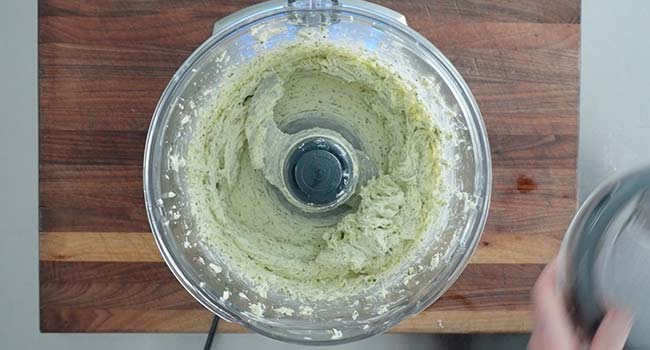
Final Sear: Once the roast is rested, I place it back in the oven on a middle rack at 500° until it reaches 118° to 120° for rare to medium-rare.
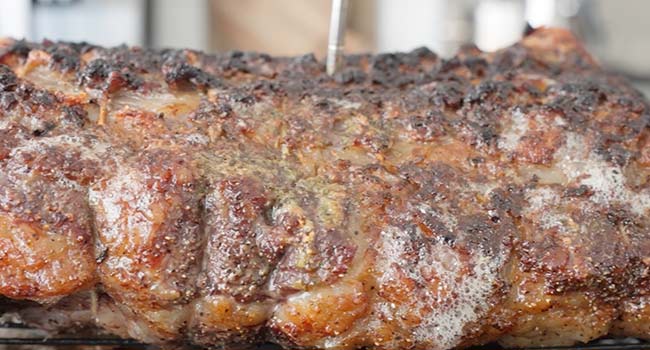
Finish with Herb Butter: I take the roast out of the oven and immediately spread a few tablespoons of the herb butter over the top, letting it melt into the meat.
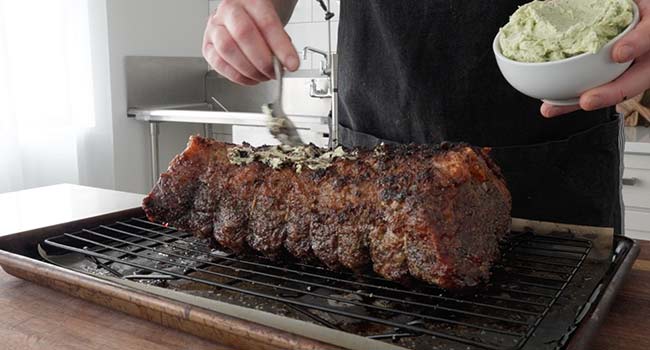
Slice & Serve: For the ultimate flavor boost, I slice the New York strip roast into thick, juicy pieces and drizzle it with bordelaise sauce.
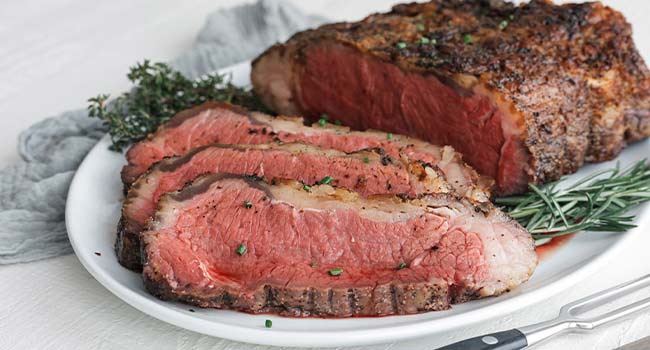

Chef Tip + Notes
To make my New York Strip Roast turn out perfectly juicy and tender, I always account for carryover cooking. I pull the roast 2 to 5 degrees before my target temperature, cover it with foil, and let it rest so the heat gently finishes the cooking.
- Maillard Reaction: When beef is heated to 285°-350°F, the sugar and amino acids react, creating that beautiful brown crust that adds incredible flavor and crispness.
- Reverse Sear Method: I slow-cook the beef at a low temperature, let it rest, and then sear it at high heat for a perfect crust. This method also works great for chicken and pork!
- Cooking Temperatures: For rare, remove the steak from the oven at 115° to 120°; for medium, 125° to 130°; for medium-well, 135° to 140°; and well-done, 140° to 150°.
- Resting & Myoglobin: When the meat rests, the myoglobin, the protein responsible for making meat red, will rush back through the beef. I’m just telling you this because it may take a little while for this to occur. If you slice it and it looks medium to well-done, give it a few seconds, as the red and pink colors will come back through.
- Best Knife Choice: I usually use a boning knife when fabricating any meat.
- Dry Brining for More Flavor: The longer the dry brine, the more flavorful it will become.
- Leftover: There will be leftover bone marrow butter, which you can use in other recipes.
- Resting Between Cooks: When reversing searing meat, a good rule of thumb is to let it rest for half the time as the initial cook. This rest will take place between the first and second cook. There is no need to rest the roast after the second cook.
- Intramuscular Fat (Marbling):Those white streaks of fat running through the beef? That’s marbling, and it’s what makes the meat juicy, tender, and full of flavor.
Serving Suggestions
I like serving this New York strip roast with a side of my Hasselback potatoes, their crispy edges and buttery layers make the perfect complement to the tender beef. For an extra flavor boost, I drizzle it with my mushroom Bordelaise sauce.
And to end the meal on a high note, nothing beats my perfect Crème Brûlée, a silky baked custard with a caramelized sugar topping that’s pure indulgence.
Make-Ahead and Storage
Make-Ahead: This is meant to be eaten as soon as cooking is done.
How to Store: Store it on a platter covered in plastic and refrigerate it for up to 4 days. It can also be frozen for up to 45 days and covered in plastic. Thaw it in the refrigerator for up to 2 days or until it is thawed.
How to Reheat: While I never recommend reheating too-temperature beef, I realize you may be unable to eat it all at once. Slice it into portions and add it to a large roasting pan with about 1 cup of beef stock. Cover it in foil and cook in the oven at 400° for 12 to 15 minutes. Reheating your steak will 100% cause it to increase in internal temperature, most likely past medium and into medium-well.
More Roast Recipes

Video
New York Strip Roast
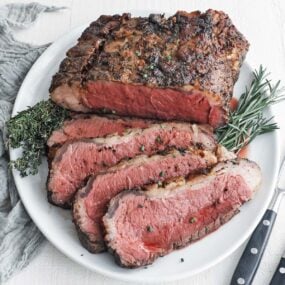
Ingredients
- 8 pound trimmed New York strip roast
- 2 tablespoons coarse salt
- 2 teaspoons ground pepper
- 4 sticks softened unsalted butter
- 1 ½ tablespoons finely minced fresh rosemary
- 1 ½ tablespoons finely minced thyme
- 2 tablespoons finely minced parsley
- 2 tablespoons thinly sliced chives
- 2 finely minced garlic cloves
- zest and juice of 1 lemon, about 2 to 3 tablespoons
- 2 tablespoons dry sherry wine, optional
- 2-4 beef shank bones, optional
- 1 tablespoons olive oil
- coarse salt and freshly cracked pepper to taste
Instructions
- Start by trimming the roast from fat on the top, bottom, and sides. All sinew, silver skin, and stringy-like fat should be removed. However, I do like to keep a ½” fat cap on the top.
- Using your knife, score the fat cap on the top going about an eighth to a max of one-quarter inch deep in both directions.
- Next, truss the beef roast using butcher’s twine.
- Place the roast on a rack over a sheet tray and generously season all sides with coarse salt and ground pepper.
- Put the roast on the rack in the fridge uncovered for 12 to 48 hours.
- Remove the roast from the fridge and let it sit at room temperature for 25-30 minutes to take the chill off it.
- In the meantime, whip the 4 sticks of unsalted butter in a stand mixer with the paddle attachment on high for 5 to 7 minutes or until it becomes light and fluffy.
- Stop the mixer and add the parsley, thyme, rosemary, chives, garlic, lemon zest, juice, salt, pepper, and sherry. Mix on low speed to combine.
- Spread half of the herb butter onto the top of the fat cap of the roast and spread it out using a rubber spatula until it is coated.
- Place a thermometer from the top into the center of the roast and reverse sear it on a middle rack in the oven at 225° until it reaches 108° to 110° internally, which takes about 2 ½ hours.
- Remove the roast, cover it with foil, and let it rest for 60 to 75 minutes.
- While waiting, turn the heat up to 500°. If you have convection, even better.
- You can next optionally coat the beef shank bones in oil, salt, and pepper, and roast on a sheet tray lined with parchment paper and roast in the oven on a middle rack for 20 to 25 minutes or until the marrow is 145° internally.
- Let the bones cool slightly before adding the marrow to a food processor along with the remaining herb butter. Pulse it until it is finely minced and combined with the butter. Set it aside.
- Once the roast is done resting, place it back in the oven on a middle rack at 500° until it reaches 118° to 120° for rare to medium-rare, which takes about 25 minutes.
- Remove the roast and spread on a few tablespoons of the bone marrow butter. Slice and serve.
Notes
- Maillard Reaction: When beef is heated to 285°-350°F, the sugar and amino acids react, creating that beautiful brown crust that adds incredible flavor and crispness.
- Reverse Sear Method: I slow-cook the beef at a low temperature, let it rest, and then sear it at high heat for a perfect crust. This method also works great for chicken and pork!
- Cooking Temperatures: For rare, remove the steak from the oven at 115° to 120°; for medium, 125° to 130°; for medium-well, 135° to 140°; and well-done, 140° to 150°.
- Resting & Myoglobin: When the meat rests, the myoglobin, the protein responsible for making meat red, will rush back through the beef. I’m just telling you this because it may take a little while for this to occur. If you slice it and it looks medium to well-done, give it a few seconds, as the red and pink colors will come back through.
- Best Knife Choice: I usually use a boning knife when fabricating any meat.
- Dry Brining for More Flavor: The longer the dry brine, the more flavorful it will become.
- Leftover: There will be leftover bone marrow butter, which you can use in other recipes.
- Resting Between Cooks: When reversing searing meat, a good rule of thumb is to let it rest for half the time as the initial cook. This rest will take place between the first and second cook. There is no need to rest the roast after the second cook.
- Intramuscular Fat (Marbling):Those white streaks of fat running through the beef? That’s marbling, and it’s what makes the meat juicy, tender, and full of flavor.


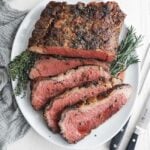
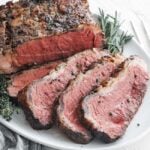
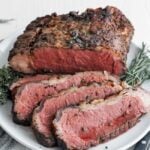
This recipe works great for whole picanha as well.
Made this for Easter Sunday. However, I picked up the wrong type of beef. I USED A TOP SIRLOIN BEEF ROAST. Went back to the store and when I saw the price of the steak you suggested I decided to give my purchase a try as it would cost me over another $150.00. Followed the recipe exactly and hoped for the Best best. I was not disappointed. When my son sliced the roast he immediately took the first bite. He said OMG this is the most tender juicy steak I have ever tasted. He was surrounded by the other GUYS and they carried on. It was wonderful. I was more than impressed with the results and will definitely make this again! WOW! Best Easter ever.
Good recovery!!
Hi there, another option for sherry wine? I don’t have at home, but I have rum. Can I use it instead? Thank you and have a nice day Chef!
I’d skip it.
Love the fresh herbs! Now the beef soup… heading ahead. Thank you for the great recipes!
my pleasure!
I have frozen sirloin tip roasts , when do I dry brine this as thawing makes juices run out?
Not sure that would work here